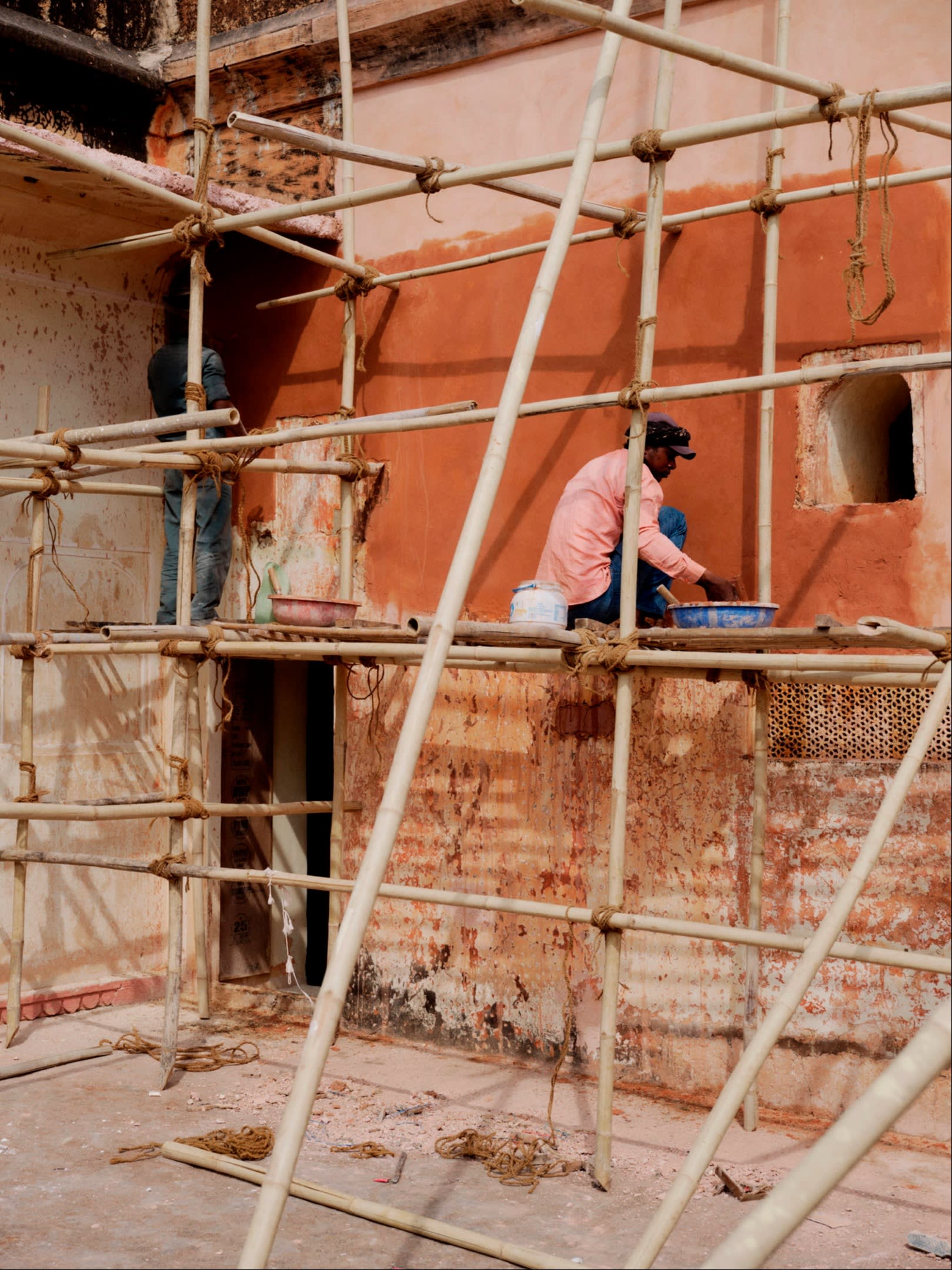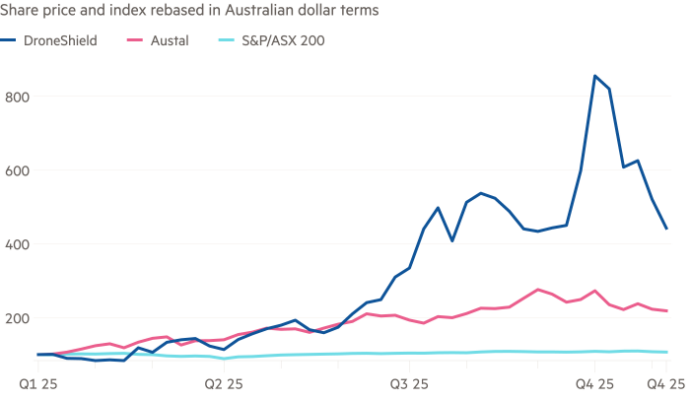For the past three centuries, whenever the Maharaja of Jaipur is in residence, two pachranga — five-coloured flags — have flown above his City Palace. The palace itself is an exuberant red, pink and cream stone labyrinth of arches, gardens, courtyards and mirrored rooms in north-west India. If you couldn’t see the flags, though, you would be in no doubt that the head of the city’s royal family is in residence today from the swell of activity.
As Maharaja Sawai Padmanabh Singh — known as Pacho by family and friends or HH, for “his highness”, by his retinue — walks down one of the palace’s corridors, red-turbaned staff in livery bend in a gentle bow. (Maharaja means “great ruler” and is equivalent to prince; sawai is an honorary title.) Wearing a casual short white linen kurta shirt and trousers, with camel-leather jutti slip-ons, he shrugs off the obeisance as he enters his office.
He is maharaja in title only since the abolition of princely power in 1971. “Today, I don’t have a democratic responsibility to our people. I’m not an elected representative. I’m not their monarch. I’m not their sovereign,” he says in his office, cluttered with family photos and effigies of the Hindu gods Shiva and Ganesh hanging from the wall. “But I have a cultural responsibility. There are still hundreds of thousands of people that culturally follow the palace, the culture, the family.
“I have to have one foot on what’s happening today and one foot thinking about what’s going to happen five or 10 years from now. I have a lot of ambitions, plans and goals for Jaipur and for our family’s properties.”

He has had enough time to get used to the pomp stemming from the titles. He was crowned the maharaja of Jaipur at 12 in 2011 after the death of his maternal grandfather, Sawai Bhawani Singh, who had adopted him as his heir. The maharaja had been at Indian and British schools and American and Italian universities, then returned to Jaipur in April 2023 to take charge of the family’s estate. His mother, Princess Diya Kumari, had become more engaged with politics and the maharaja was frustrated with how things were being run overall, he said.
“She had no more time to do anything else,” he says. “That’s when I started getting involved, to understand what was going on and how I could contribute positively to what our family’s work is and what we are doing.” There are political-dynastic synergies: he wants to focus on tourism and his mother is now a deputy chief minister for the state of Rajasthan, with a portfolio that includes tourism. “What she’s doing on a larger scale for the state, I want to do it for the family.”

Even those who know nothing about India’s royal families may recognise the maharaja, the latest ruler of a dynasty spanning a millennium. The 26-year-old — modest, energetic, handsome, chatty — has more than 550,000 followers on Instagram, where he poses in the palace’s elaborate chambers and extensive gardens or is caught mid-swing on a polo pony.
Outside his office, in the inner Pritam Niwas courtyard, tourists take photographs at the four gates, adorned with peacocks and themes representing the four seasons and Hindu gods, some still under scaffold per the maharaja’s renovation scheme. “I’m now in charge,” he says, “of keeping our family assets and estate going, but also we have to think for the city and how do we keep the cultural landscape of the whole city going.”
Altogether, the maharaja — almost too affable to be regal — has turned himself into restaurateur, hotelier, polo player, art patron, interior designer, fashionista, influencer and heritage guardian. He became the first royal to (briefly) rent out part of the City Palace on Airbnb — for $8,000 a night — but he has also invested in restoring palaces and forts, running hotels and resurrecting a polo team. His challenge is to keep majesty and modernity in perfect balance even as he turns legacy into a brand.

When India gained independence from Britain in 1947, Jaipur was just one of the more than 560 princely states that covered two-fifths of the subcontinent. But independence and democracy brought with them an end to the feudal order, and in 1971 royal families’ privy purses and special privileges were abolished by Prime Minister Indira Gandhi for being “incompatible with an egalitarian social order”. Constitutionally, they have no more rights than any other Indian citizen. But the members of the erstwhile royal families continue to use their titles.
Ever since their power and wealth, the sort once symbolised by parades of elephants with iron, leather and silk caparisons, were abruptly ended, the Rajput clans who once ruled over much of northern and western India have been forced to redefine themselves. Some vanished into oblivion while others became army officers or diplomats, politicians or patrons.
The Jaipur family decided to pursue varied ambitions, putting to use their patrimony, winning political power and developing an entrepreneurial spirit. A family that has gone from Rajasthani feudalism to British imperialism to the world’s largest democracy now lives in a palace that is visited by as many as 2mn tourists a year.
At the Palace Atelier shop, stocked by the maharaja’s sister, Princess Gauravi Kumari, some of these tourists now buy fancy clothes and memorabilia, such as small replicas of the 4,000-litre sterling-silver vessels that Maharaja Sawai Madho Singh II used to carry the water of the Ganges to England for Edward VII’s coronation. The maharaja and his sister also run the Princess Diya Kumari Foundation, a non-profit for women from impoverished communities whose handicrafts are sold at the PDKF Store in the City Palace.
In Rajasthan, “you now have to look at the young scions of erstwhile royalties as entrepreneurs,” says historian Khushi Singh Rathore. The maharaja has taken that to heart. But not everyone welcomes his family’s continued, insistent prominence. “These royals were there before us, so we have to live with them,” says a senior Rajasthani opposition politician. “Asking if they are useful today, it’s like asking if a dog’s tail is useful. It’s just there, wagging, and it will still be there, just wagging.”


“In the hierarchy of India’s princely states, Jaipur was not the most important, but it was the most evocative, the most romantic, the most glamorous,” wrote historian John Zubrzycki in The House of Jaipur. Without subjects and privy purses, “Rajput valour, once tested on the battlefield, is now being played out on the political domain and in corporate boardrooms and on the sporting field.”
For the Jaipurs, enterprise started in 1957 when the Rambagh Palace, home of the current maharaja’s great-grandfather Sawai Man Singh II and his third wife Gayatri Devi, was converted into a luxury hotel run by the family. Jai and Ayesha, as the couple were known, were India’s answer to the Camelot of John and Jackie Kennedy. Jai died suddenly in 1970, aged 57, playing polo in England, leaving behind three wives, several children, properties and trusts; inheritance disputes followed.
In 1972, the Rambagh Palace’s management was handed over to the Taj Hotels group; US vice-president JD Vance stayed there in April. “We are minority shareholders of the Rambagh Palace,” says the maharaja. His office, which once belonged to Jai, is decorated with Egyptian frescoes, mementos from his great-grandfather’s trips to Cairo piloting his own plane. “Between the whole family we have seven, eight hotels, but in some we are not at all there” as managers, he adds.

The commercial properties within the Jaipur family’s portfolio include the rose-coloured, recently refurbished Rajmahal Palace hotel, built in 1729 as a retreat for a wife of Maharaja Sawai Raja Jai Singh II. In 1821 it became the official home of a British colonial administrator and then, in 1958, of Jai. Over the years, it hosted Queen Elizabeth II, the Shah of Iran and — bringing Camelot to Jaipur — Jackie Kennedy.
It is now a luxurious heritage hotel with an art deco vibe and almost three dozen bespoke wallpapers, created a decade ago by Princess Diya and Indian designer Adil Ahmad. The property, with 13 rooms or suites including two royal apartments, is owned by the family and operated by management company Raas, under the maharaja’s oversight. A vintage Ford Thunderbird car, customised for the royal family with the number plate JAIPUR 1, is parked at the hotel; the Maharani Suite goes for $10,500 a night during peak season.
Others are watching and learning from the young maharaja. “The City Palace is the nucleus of Jaipur,” he says, “but there are other owners of buildings, of havelis, a series of small palaces, that are now thinking, ‘I’m going to do this,’ and it’s really spurred this regeneration movement in the old city . . . with that personal touch, that actual curiosity to be able to package the most authentic offering.”
Many investments come out of the family’s purse, he says. His most recent venture is The Sarvato, a restaurant offering a tasting menu of Rajasthani dishes managed by Mumbai-raised, New York-based hotelier and restaurateur Abhishek Honawar. It is located on the Sarvato Bhadra, an elevated open-air pavilion at the heart of the City Palace where the maharajas used to host private audiences with visitors.
“It’s a great time to be here,” said Honawar. The maharaja is “actually unstoppable right now”.
“Polo is really what makes my heart beat,” says the maharaja as he hops on to his horse, boots on, mallet in hand, at the Rajasthan polo club to play in the final of the Maharaja Sawai Man Singh Polo Cup.
In between chukkas, wearing his team shirt in the colours of his Kachhwaha clan, he is tended by helpers who rush to hand him towels to dry his sweat, give him water and change his gloves. A painted elephant and camels had paraded around the grounds to open the game, pomp he vocally detests as it riles up some of the two dozen horses he owns. (They are mainly from Argentina, the world’s polo powerhouse.)
The maharaja started playing at 12 and competitively soon afterwards; three years ago, he reached a four-goal handicap, which means he is considered a strong player. But his dream of following Jai, once one of the world’s best players, has all but vanished since a car wreck in Scotland last year broke his back and paralysed him for six weeks, leading to rods being fixed in his back. He was in the saddle as soon as he could and has since been playing around India during the cooler season and in Argentina and France during India’s scorching spring.

After ride-offs and penalties, the final is not the shoo-in for the maharaja’s Jaipur team that some had expected. But he shows skill, whacking the ball past the goalposts, and his team clinches the cup with a 9-8 victory. “Polo is more than just a sport — it is a legacy, a tradition, a way to connect with our history,” he says. In a corridor of the City Palace, photos of Jai alongside the last viceroy of India, Lord Mountbatten, and a young Prince Philip, all in full polo gear, adorn the wall.
But like the rest of his legacies, he also sees it as a way forward. As owner and captain, he has resurrected the team, which had been dormant for years in the absence of a leading figure, and attracted the Adani Group, owned by one of India’s richest men, as a sponsor. He has boosted the club, including an entire re-laying of the grounds for the first time in 40 years. Last year he opened the Polo Palladio restaurant and bar, which attracts Jaipur society. “This is Jaipur at its best,” says one club member as he sips a gin and tonic.
As the chair of the Maharaja Sawai Man Singh II Museum, the maharaja has launched what he calls “a huge conservation drive” across the City Palace. The grounds are packed with workers restoring frescoes, gold-and-silver plated canopies and artefacts, including some “almost forgotten” in storage rooms. “We don’t know how many articles we have,” he says, “and I’m of the firm opinion that it’s not my personal possession . . . This palace and some of the articles in the collection are our shared cultural heritage and the people of India have as much of a right to interact with them as I have. It has to be shared.”
Early in his journey, the maharaja of Jaipur took some advice from the maharaja of Jodhpur, Gaj Singh: “He said to me that, in the end, you have a cultural responsibility . . . People come here to grab a piece of the culture that they cannot get anywhere else. If you do not keep that culture going, or if you do not find young people or people of your generation to find pride and to find some sort of association with this culture, it’s going to die.”
The maharaja wants to model himself on Sawai Jai Singh II (1688-1743), whose goal was for Jaipur to be a local, national and global gathering place “that excelled in art, craft, fashion, creativity and contemporary thinking”, the maharaja says. As he gears up for a gala for the Jaipur Centre for Art, a contemporary art gallery located within the City Palace grounds, he dons a tailored bandhgala jacket with a pocket square in pachranga colours and adds: “In whatever I do, if Jai Singh looks at me, he should be proud.”
Andres Schipani is the FT’s New Delhi correspondent


